#PCB Design Software
Explore tagged Tumblr posts
Text
Pcb Design Software Market Is Anticipated to Witness High Growth Owing to Growing Adoption of Advanced Electronics
Printed circuit board (PCB) design software enables engineers and designers to create schematics, perform layout planning, simulate signal integrity, and execute design rule checks for diverse electronic applications. These tools streamline the development of consumer electronics, automotive systems, aerospace hardware, and IoT devices by automating manual drafting processes, reducing design errors, and accelerating time-to-market.
Key advantages include comprehensive component libraries, real-time collaboration features, and advanced routing algorithms that enhance board density and thermal management. As product lifecycles shorten and electronic complexity rises, manufacturers increasingly rely on Pcb Design Software Market Growth solutions to achieve higher yields and lower development costs while ensuring compliance with industry standards. Moreover, integration with cloud-based platforms allows remote teams to share market insights and design data securely, supporting global expansion strategies and agile iterations. Get more insights on: Pcb Design Software Market Get This Report In Japanese Language: PCB設計ソフトウェア市場
Get This Report In Korean Language: PCB 설계 소프트웨어 시장

#Digital Transformation#PCB Design Software#PCB Design Software Market#PCB Design Software Market Insights#PCB Design Software Market Trends#Coherent Market Insights
1 note
·
View note
Text
The global PCB design software market is set to experience significant growth between 2023 and 2033. A research report by Future Market Insights suggests that the market will surpass a value of US$ 4,041.4 million in 2023 and is projected to reach US$ 16,538.7 million by 2033. This represents a remarkable CAGR of 15.1% during this ten-year period.
0 notes
Text
Understanding Gerber Files and Schematic Drawings in PCB Manufacturing
0 notes
Text
PCB Manufacturing in Toronto: Expertise, Services, and Local Industry Insights
Discover PCB manufacturing in Toronto, a hub of innovation and quality in electronic manufacturing services. Learn about the specialized capabilities, technological advancements, and diverse offerings of PCB manufacturers Toronto. Explore how local expertise and cutting-edge facilities contribute to producing high-quality printed circuit boards for various industries and applications worldwide. For more details visit our website www.crimpcircuits.com
#pcb manufacturing toronto#printed circuit board design#metal clad pcb#printed circuits#rigid flex pcb#full turnkey pcb services#turnkey pcb services#pcb parts#eagle software#pcb designing#flexible pcb#pcb assembly#printed circuit board manufacturers#pcb manufacturers in canada#circuit board manufacturers in canada#pcb quote#pcb prototype services in canada
2 notes
·
View notes
Text
Helpful Analysis of the Latest Printed Circuit Board Design Software
Navigating the ever-evolving landscape of PCB technology demands the right tools, especially when working with prototype circuit board projects that require precision and efficiency. Quick turn PCB fabrication plays a vital role in accelerating innovation and cutting down lead time, making modern design tools indispensable for engineers and developers.
Enhancing Accuracy Through Structured PCB Design
To streamline complex circuits and ensure optimal performance, structured design methods offer better control and consistency. These strategies are essential for professionals working on intricate PCB layout design or utilizing advanced printed circuit board design software to meet tight development cycles. From seamless design integration to real-time collaboration, today’s software solutions empower engineers to move from concept to final board faster. Bay Area Circuits supports innovation with services like high-quality prototype production and rapid assembly. Visit their website and explore their services.
For more reading, Visit here - https://67d7ed103fe91.site123.me/blog/helpful-analysis-of-the-latest-printed-circuit-board-design-software
#Quick turn PCB fabrication#prototype circuit board#PCB layout design#printed circuit board design software
0 notes
Text
#Consumer Electronics Product Design#Electronic Product Design Services#PCB Design Companies in India#IoT Embedded Systems#PCB Board Design Software
0 notes
Text
Global PCB Design Software Market Is Estimated To Witness High Growth Owing To Increasing Demand for Advanced Electronics
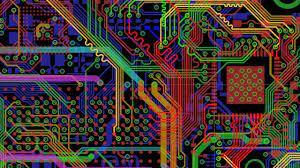
A) Market Overview: PCB design software is a computer-aided design tool used to create layout designs for printed circuit boards (PCBs). These software tools offer numerous advantages such as enhanced efficiency, accuracy, and productivity in the design process. With the rapid advancements in technology and the increasing demand for advanced electronic devices in various industries, the need for PCB design software has become crucial. This software enables engineers and designers to create complex and highly functional PCB designs, ensuring proper connectivity and signal integrity. The global PCB design software market is expected to witness significant growth due to the growing adoption of advanced electronics across various industries such as automotive, aerospace, consumer electronics, healthcare, and telecommunications.
The global PCB Design Software Market Size is estimated to be valued at US$3.56 billion in 2022 and is projected to grow at a CAGR of 12.3% from 2023 to 2030, according to a market research report published by Coherent Market Insights.
B) Market Key Trends: One key trend in the PCB design software market is the adoption of cloud-based solutions. Cloud-based PCB design software offers several advantages over traditional on-premise software. It enables remote collaboration, allowing multiple stakeholders to work on the same design simultaneously. Cloud-based solutions also provide easy access to design files from anywhere and on any device, facilitating seamless workflow and faster decision-making. Moreover, cloud-based software eliminates the need for expensive hardware infrastructure, reducing costs and improving scalability. For example, Altium LLC, a key player in the PCB design software market, offers Altium 365, a cloud-based platform that enables collaborative PCB design. C) PEST Analysis: Political: The political environment plays a significant role in the growth of the PCB design software market. Government regulations and policies regarding intellectual property rights and data security can impact the adoption of PCB design software. Economic: The economic factors such as GDP growth, industrial development, and disposable income influence the demand for PCB design software. The growth of end-user industries such as automotive, aerospace, and consumer electronics drives the market. Social: The social factors such as changing consumer preferences, increased awareness about advanced electronics, and the need for innovative products drive the demand for PCB design software. Technological: Technological advancements in the field of electronics, such as the integration of IoT, AI, and 5G technology, are driving the demand for advanced PCB designs. PCB design software needs to keep up with these technological developments to meet the evolving requirements of the industry. D) Key Takeaways: - The global PCB design software market is expected to witness high growth, exhibiting a CAGR of 12.3% over the forecast period, due to increasing demand for advanced electronics. - North America is expected to dominate the PCB design software market, owing to the presence of key players, technological advancements, and early adoption of advanced electronics. - Cadence Design Systems, Inc., Altium LLC, and WestDev Ltd. are some of the key players operating in the global PCB design software market. In conclusion, the global PCB design software market is poised for significant growth in the coming years. The increasing demand for advanced electronics and the adoption of cloud-based solutions are driving factors for this market. However, political, economic, social, and technological factors will continue to influence the market dynamics. Key players in the market are focusing on innovative solutions to cater to the evolving needs of the industry.
#PCB Design Software Market#PCB Design Software Market Size#Coherent Market Insights#PCB Design Software Market Demand#PCB Design Software Market Trends#PCB Design Software Market Forecast
0 notes
Note
Cactus fascinates me, does it run on code similar to an existing instruction set or is it completely original on that front?
What can you do with it? What's it's storage?
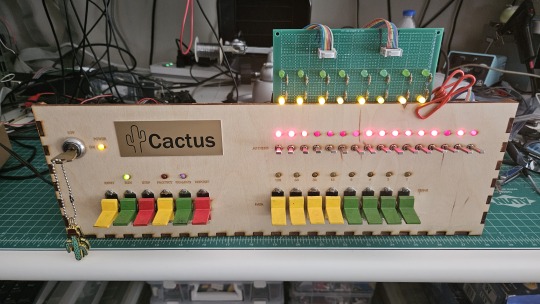
Both the Cactus (the original wooden prototype from years ago) and the new PCB Cactus(es) are essentially derived from a minimal 6502 computer design by Grant Searle for their core logic. Here's what that would look like on a breadboard:
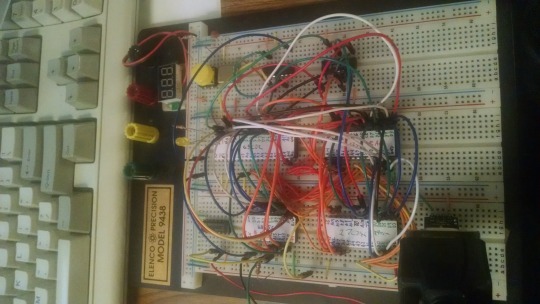
There isn't much to it, it's 32K of RAM, 16K of ROM containing Ohio Scientific's version of Microsoft BASIC, a 6850 ACIA for serial interaction, some logic gates, and of course a 6502 microprocessor (NMOS or CMOS, doesn't matter which). You hook it into a terminal and away you go.
Grant's design in turn can be best described as a distilled, modernized version of the OSI Challenger series of computers. Here's an OSI-400 and a Challenger 4P respectively:
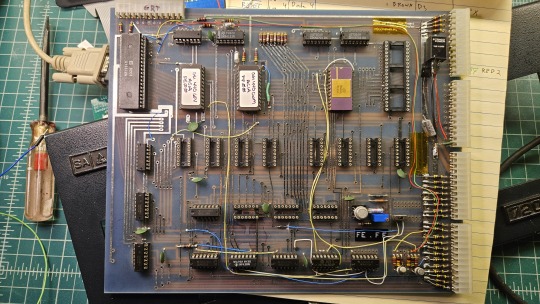

The left one is a replica of the 400 circa 1976, also called the Superboard. It was affordable, endlessly reconfigurable and hackable, but ultimately very limited in capabilities. No BASIC, minimal monitor ROM you talk to over serial, but you could connect it to a bus to augment its features and turn it into a more powerful computer.
Whereas the OSI C4P on the right from about 1979 has more RAM, a video card, keyboard, BASIC built in, serial interface, cassette tape storage, and that's just the standard configuration. There was more room to expand and augment it to your needs inside the chassis (alot changed in 3 years for home computer users).
Grant's minimal 6502 design running OSI BASIC is a good starter project for hobbyists. I learned about the 6502's memory map decoding from his design. I modified and implemented his design on a separate cards that could connect to a larger backplane.
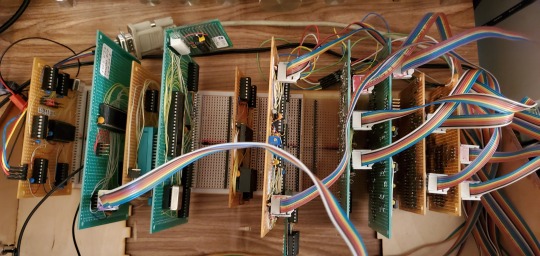
Here are the serial, ROM, RAM, and CPU cards respectively:
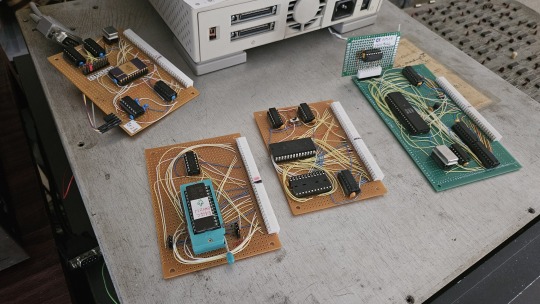
Each one is 100% custom, containing many modifications and fixes as I developed the design. However, that's only half of the computer.
I really wanted a 6502 machine with a front panel. People told me "nobody did that", or couldn't think of examples from the 1970s but that seemed really strange to me. Especially since I had evidence to the contrary in the form of the OSI-300:
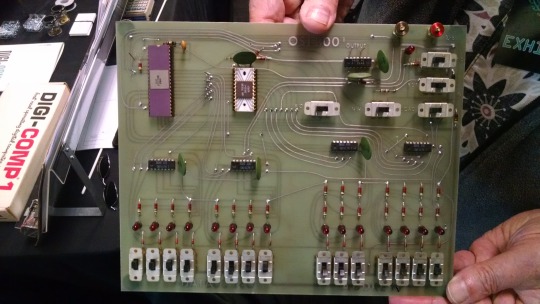
This one I saw at VCF West back in 2018 illustrates just how limited of a design it is. 128 bytes of RAM, no ROM, no serial -- just you, the CPU, and toggle switches and LEDs to learn the CPU. I was inspired the first time I saw one in 2015 at VCF East, which is probably when this whole project got set in motion.
Later that year I bought a kit for a miniature replica OSI-300 made by Christopher Bachman, and learned really quickly how limited the design philosophy for this particular front panel was. It was a major pain in the ass to use (to be clear, that's by OSI's choice, not any fault of Christopher in his implementation)

So... I designed my own. Took awhile, but that's the core of what the Cactus is: my attempt at experiencing the 1970s homebrew scene by building the computer I would have wanted at the time. Over half of the logic in the Cactus is just to run the front panel's state machine, so you can examine and modify the contents of memory without bothering the 6502. I added in all of the things I liked from more advanced front panels I had encountered, and designed it to my liking.
Here's the original front panel, accompanying logic, and backplane connected to the modern single board computer (SBC) version of the machine:

And here's the new Cactus SBC working with the new front panel PCB, which combines the logic, physical switch mountings, and cabling harnesses into a single printed circuit board.
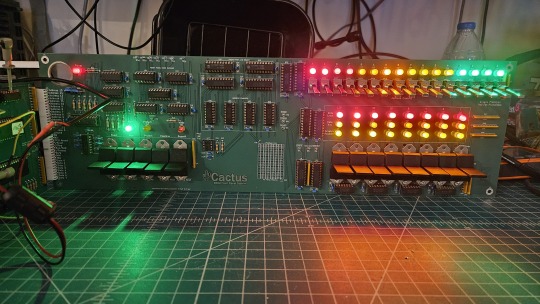
So, what can you do with it? Pretty much the same things I do already with other contemporary 1970s computers: play around in BASIC, fire up the occasional game, and tinker with it.
I've got no permanent storage designed for the Cactus as yet, it's been one of those "eventually" things. The good news is that a variety of software can be ported to the hardware without too much trouble for an experienced hobbyist. A friend of mine wrote a game called ZNEK in 6502 assembly which runs from a terminal:
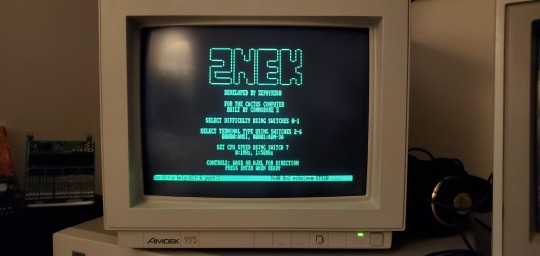
Right now, you have to either toggle in machine programs from the front panel from scratch, burn a custom ROM, or connect it to a serial terminal to gain access to its more advanced features:

Here's it booted into OSI BASIC, but I have also added in a modern descendant of Steve Wozniak's WOZMON software for when I need to do lower level debugging.
I've also got a video card now, based on the OSI-440. I have yet to implement a keyboard, or modify BASIC to use the video board instead of the serial connection. Even if I did, screen resolution is pretty limited at 24x24 characters on screen at once. Still, I'm working on that...
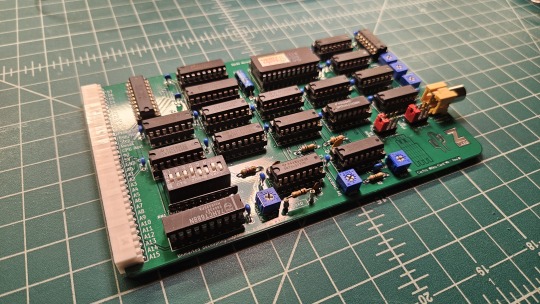

Anyway, I hope that answers your question. Check the tags below to see the whole process stretching back to 2017 if you're curious to learn more of the project's history. I'm also happy to answer any more questions you might have about the project.
267 notes
·
View notes
Text
it's still so over
5k/10k of my thesis completed 👍 we might be so back (<- girl who has 3 days to do the rest)
#of all the things to be stuck on#i am stuck on importing a simm model to opensim#help . helpppp#how many hours of my degree have been spent on figuring out software 😭#too many#is the answer#nothing will ever be as bad as eagle pcb design though#its fine i can do this#in . checks diary. 2 days 😭😭😭😭😭#😔✊️😭😬😫#i feel like as soon as i have this sorted it will be smooth sailing#(<- lies)
23 notes
·
View notes
Text
I bought an 8bitdo Retro mechanical keyboard!

(Picture not mine, source from PC World.)
I wanted a plastic keyboard, I really do not actually use the knob on a Keychron board I have, it still comes in a scooped keycap profile, and it has a companion numpad with a calculator built in. Win/win/win!
This keyboard comes in four designs (not colorways, full designs) themed after the NES, the Famicom, the IBM Model M, and the Commodore 64 keyboard. The NES keycaps have multiple different fonts on them, the Famicom keycaps have Japanese sublegends, the Model M keycaps have a mock stepped Caps Lock key, and the Commodore 64 keycaps are an apparently off-the-shelf SA set from one of many, many, many keycap companies floating around China (I recognize their font and profile shape from Akko ASA keycaps and numerous other scooped profile keycap sets you can have cheaply off of Aliexpress and Amazon. Do check those out, genuinely, you'd struggle to find a bad scooped keycap set these days and I love scooped profiles over Cherry and OEM.)
The build quality of the actual keyboard itself is good, feels like a very similar plastic blend to what 8bitdo uses for its controllers like their Pro 2. Stabilizers are smooth and don't rattle, the legends on the keycaps are reasonably sharp and in NES-appropriate font, the keycaps themselves are MDA profile (I would prefer SA, but beggars can't be choosers) and are somewhat thin but still good quality, dye-sublimated PBT, no warp on the spacebar. Arrow keys are a separate color from the two tones that make up the main keycap set and made to resemble a d-pad. The keyboard itself is somewhat light, but my perception is skewed from using a metal keyboard for a long time, and this is after all a plastic shell, top-mounted keyboard. Even so I think I'll probably end up cracking open the keyboard and putting in some liquid silicone as noise-dampening and additional weight.
Two knobs control both wireless functionality and computer software volume, the wireless knob is heavy with only three options while the volume one is light with many individual steps. The volume knob can be somewhat unresponsive on individual steps. Bluetooth is very responsive and wants to pair with my computer the moment it's flicked over to, and 2.4ghz wireless comes with a receiver that slots into the back of the keyboard magnetically for storage. A power light on the right of the keyboard mimics the NES power light and pulses while charging, is steady while using wireless or when fully charged and connected over USB.
The underlying PCB is south-facing hotswap sockets (who the hell cares their orientation, this only matters for lighting, which this keyboard doesn't have). By default the keyboard comes with Kailh box whites, a very light clicky switch. I yanked them out immediately and put Boba U4T tactiles in because they're the king of all switches. They thunk nicely in this chassis, the Kailh whites weren't slouches either, they did pick a good stock choice for switch without resorting to Gateron or Outemu blue horseshit.
The NES version of the keyboard came with a two-button macro pad that hooks over TRRS cable (you recognize it as a 3.5mm jack or headphone cable) to one of four ports on the top-right of the keyboard. These are essentially just two keyboard switches with giant keycaps on a separate board and the buttons are populated by Gateron greens. The switches are nowhere close to heavy enough to approximate a button, and I gave them Kailh box navies. Still not enough, but better.
These keyboards also come wiiiiiith a companion number pad!

(Picture credit the 8bitdo store.)
While I don't actually have this one in hand just yet I do have it on order. It looks like it'll be about the same build quality as the main keyboard, and it caught my eye for four reasons and ended up making me purchase the full set as a result:
The numpad has a built in calculator.
Same aesthetic choices as the main keyboard (NES, Famicom, IBM Model M, Commodore 64)
Magnetically attaches to the right side of the keyboard to transform it into a more era appropriate full-size.
Far and away the cheapest wireless mechanical numpad with calculator on the market, sitting at $45.
An important note though is that the Famicom and NES keypads don't attach to their respective keyboards, simply because their respective keyboards don't have magnets inside the sides of the chassis to allow for it. I have some cheap button magnets laying around that I'll use for this purpose and probably see if they're strong enough to be placed on the inside of the board and allow for the numpad to connect to it. I also imagine there's going to be a repop or v2 of this keyboard in the future that has this done already, seeing as the Commodore 64 version of the board and I believe the Model M version of the board already have that.
I'll reblog this and give some actual definitive thoughts on the numpad once it's in my hands.
As far as the board itself is concerned, I quite like it. The keycap profile is agreeable, the nostalgia pandering targeted me with laser precision, the board sounds quite good acoustically (especially for being a top-mount keyboard!) and it has a volume knob I'll see if I can reprogram some day. While I normally hate TKL layouts, I'm putting up with it because it will eventually be a fullsize with the numpad. Worth $150 total? Don't know, can't answer that for you, it's worth it to me but I very specifically wanted a keyboard themed after an old Nintendo console with no setup required and no chasing down or commissioning GMK keycap sets. I also wanted a calculator numpad.
#look at my flop reviews boy#mechanical keyboards#keyboards#mechanical keyboard#keyboard#tech#gadgets#computers#nintendo#NES#nintendo entertainment system
47 notes
·
View notes
Text

Giving Tuesday – KiCad open-source design #GivingTuesday 💻🔧🌍❤️🤝
KiCad is an open-source software suite for electronic design automation (EDA), enabling users to design schematics and printed circuit boards (PCBs). KiCad is a great, free, open tool for creating complex designs, from hobbyist projects to professional-grade hardware. As an open-source initiative, KiCad promotes accessibility and collaboration, making advanced EDA tools freely available. Supporting KiCad helps the development of features, bug fixes, and community-driven improvements, empowering engineers, educators, and hobbyists worldwide. Consider donating to KiCad to strengthen the open-source hardware community and help make high-quality EDA tools accessible to everyone.
In the past year, they posted this nifty chart that shows what your support can help accomplish.

If KiCad is valuable to you, please consider donating to help make it even better.
#kicad#kicadpcb#electronics#eda#schematic#pcbdesign#pcblayout#opensource#edatools#openhardware#donatetoday#engineeringdesign#communitysupport#openedsystems#opensourcecommunity#pcbtools#givingback#generositymatters#techforgood#makercommunity#electronicsdesign#designsoftware#kicaddonation#hardwaredesign#opensourceinitiative#techcommunity#sharekindness
11 notes
·
View notes
Text
The global PCB design software market is set to experience significant growth between 2023 and 2033. A research report by Future Market Insights suggests that the market will surpass a value of US$ 4,041.4 million in 2023 and is projected to reach US$ 16,538.7 million by 2033. This represents a remarkable CAGR of 15.1% during this ten-year period.
PCB design software helps shorten project timelines and enables PCB manufacturers to meet market demands more efficiently. It reduces production expenses and enhances the appearance of end products. The growing need for innovation, functionality, and shorter product lifecycles is driving industries to utilize these tools more effectively.
0 notes
Text
Does anyone know where I can commission fully custom keyboard? or where to even start? with making one myself Like I don't mean buying a custom keyboard template either. I mean fully custom PCB, shell, everything. I complained on twitter about it, but honestly I've been wondering if it would be worth my time to whip up and learn all of the tools needed to design the keyboard then map it using software like VIA or VIAL. Not sure how expensive it would be to get a printed shell, or even get an aluminum case milled or something. I know that PCB's are kinda cheap.
50 notes
·
View notes
Text



So excited to have my hands of the first proper prototype of my NuaCam project. It's crazy to see just how far I have come in a few short months, growing this from a simple idea to a functional device. The goal is to build a camera which utilising ai stylisation to capture reality in a new light. Now I can focus on improving the ai side to try and create exciting styles to use. The first prototype was causing lots of lost hours debugging due to lose wires, so I bite the bullet and designed this pcb to help me develop the software side.
#embedded#technology#electronic project#electronics#startup#camera#ai photography#hobby#pcb#pcb assembly#electronic engineering#project#nuacam
17 notes
·
View notes
Text
Leading PCB Manufacturers in Canada: Quality and Innovation
Discover the top PCB manufacturers in Canada that specialize in providing high-quality printed circuit boards for various industries, including aerospace, automotive, medical, and consumer electronics. These companies offer a range of services, from prototype development to mass production, ensuring precision engineering and compliance with international standards. With state-of-the-art technology and skilled professionals, Canadian PCB manufacturers are committed to delivering innovative solutions, fast turnaround times, and exceptional customer service. Partner with these trusted manufacturers to meet your electronic design and manufacturing needs.
#pcb manufacturing toronto#printed circuit board design#metal clad pcb#printed circuits#rigid flex pcb#full turnkey pcb services#turnkey pcb services#pcb parts#eagle software#pcb designing#flexible pcb#pcb assembly#printed circuit board manufacturers#pcb manufacturers in canada#circuit board manufacturers in canada#pcb quote#pcb prototype services in canada
0 notes